You’ll find that solid gold offers unmatched durability and lifetime value retention, making it ideal for heirloom pieces despite higher upfront costs. Gold-filled jewelry provides an excellent middle ground, lasting up to 30 years with proper care while costing considerably less than solid options. For daily wear, gold-filled pieces resist tarnishing and handle water exposure well, though they can’t be repaired like solid gold. Your choice depends on budget, lifestyle, and whether you’re seeking trendy accessories or long-term investments that’ll serve you for decades.
Understanding Gold Purity and Construction Methods
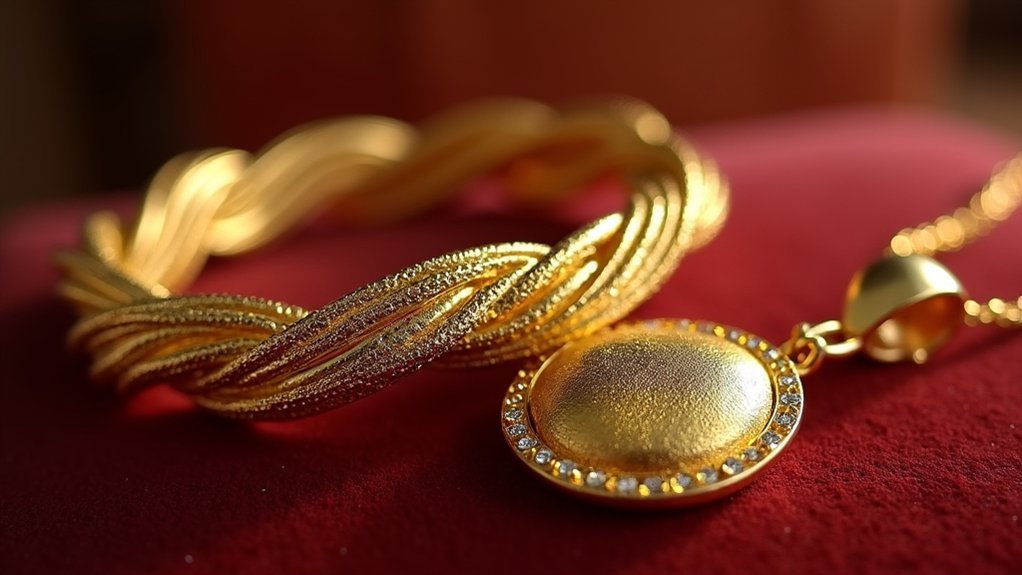
When you’re shopping for gold jewelry, understanding the fundamental differences in construction methods will help you make an informed decision that matches your budget and lifestyle needs.
Solid gold uses pure gold or gold alloys with varying karat ratings, offering the highest durability and value retention.
Solid gold delivers unmatched durability and long-term value, making it the premium choice for discerning jewelry buyers.
Gold-filled jewelry bonds a thick gold layer to a base metal core, requiring at least 5% gold content for superior longevity compared to alternatives.
Gold plating applies only a thin gold coating over base metals, making it the most affordable but least durable option.
Gold vermeil elevates standard plating by using sterling silver as the base metal with stricter thickness requirements, creating a middle-ground choice between basic gold plating and premium solid gold pieces.
Durability and Longevity Comparison Between Gold Types
Since durability directly impacts your jewelry investment’s long-term value, solid gold emerges as the clear winner for longevity and wear resistance.
You’ll find that solid gold won’t tarnish or fade, maintaining its beauty indefinitely with proper care. It’ll retain its value over decades, making it perfect for heirloom pieces.
Gold-filled jewelry offers an affordable alternative with impressive durability, lasting up to 30 years with regular wear. Its thick gold layer resists tarnishing better than cheaper options, providing excellent value for your investment.
However, gold-plated jewelry disappoints in longevity comparisons.
You’ll likely need replacement within months to a few years as the thin coating wears away quickly. While initially budget-friendly, frequent replacements make it costly long-term compared to solid gold’s permanent durability.
Cost Analysis and Value Retention Over Time
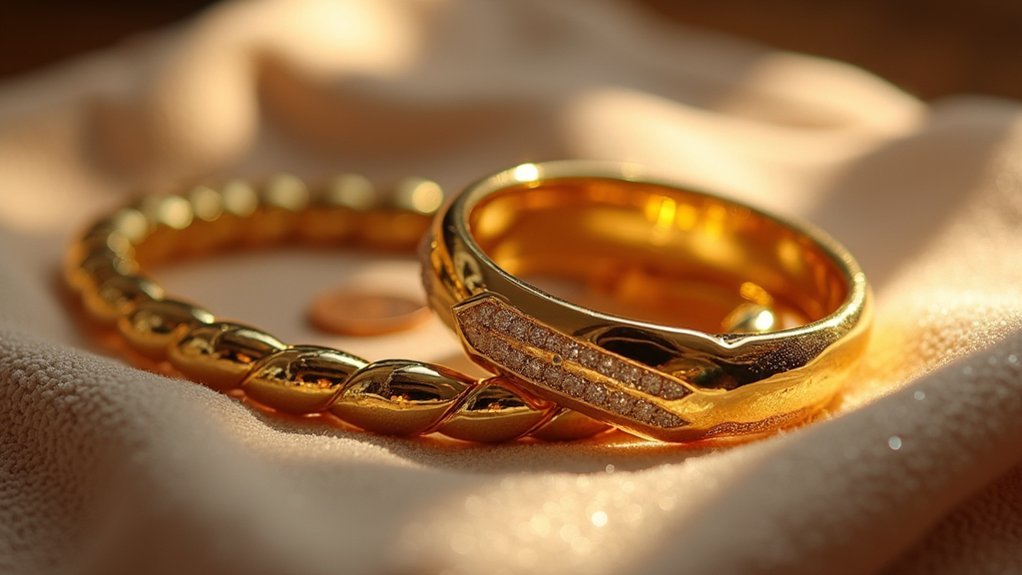
While solid gold jewelry demands a higher upfront investment—often several hundred dollars per piece—its superior value retention makes it the smarter financial choice for long-term ownership. You’ll find that cost-per-wear calculations favor solid gold jewelry over gold-filled options due to its exceptional durability and lifespan.
| Factor | Solid Gold | Gold-Filled |
|---|---|---|
| Initial Investment | $300+ | $20-$100 |
| Lifespan | Lifetime | Up to 30 years |
| Resale Value | High retention | Minimal/none |
| Repairability | Fully restorable | Cannot repair |
Gold-filled options offer immediate affordability but lack the value retention that makes solid gold a true investment. While you’ll pay more initially, solid gold’s ability to maintain worth and withstand daily wear without degradation creates superior long-term value compared to gold-filled alternatives.
Best Gold Filled Options for Daily Wear
When you’re selecting gold filled jewelry for daily wear, you’ll want pieces that can withstand your active lifestyle while maintaining their beautiful appearance.
The key lies in choosing well-constructed items and understanding how to care for them properly.
Let’s explore what makes certain gold filled pieces ideal for everyday use and the simple maintenance practices that’ll keep them looking stunning for decades.
Durability for Everyday Use
Although many jewelry lovers hesitate to wear their favorite pieces daily, gold filled options offer the perfect solution for those who want durability without compromise.
Unlike gold plated jewelry that chips and fades quickly, gold filled pieces feature a substantial gold layer bonded to base metal, ensuring exceptional longevity for everyday wear. You’ll find these pieces resist tarnishing and handle water exposure better than their plated counterparts, making them ideal for active lifestyles.
The hypoallergenic properties mean you won’t experience skin reactions common with cheaper alternatives.
While solid gold offers ultimate durability, gold filled jewelry provides remarkable resilience at a fraction of the cost. With proper care, you’ll enjoy your gold filled pieces for decades without visible wear.
Care and Maintenance Tips
Maximizing your gold filled jewelry’s impressive 30-year lifespan requires simple yet consistent care practices.
Unlike solid gold, gold filled pieces need protection from water, sweat, and harsh chemicals that accelerate wear. You’ll want to clean gold filled jewelry regularly using a soft cloth to remove dirt and oils that dull its shine.
Proper storage matters greatly for this durable choice. Store gold filled items in cool, dry places using airtight containers to prevent moisture damage.
This care and maintenance approach prevents pieces from fading with time, unlike gold plated alternatives that deteriorate quickly.
Your daily wear accessories deserve this attention since gold filled jewelry offers sustainable luxury without requiring expensive replating that other options need.
Top Solid Gold Pieces for Investment and Heirlooms
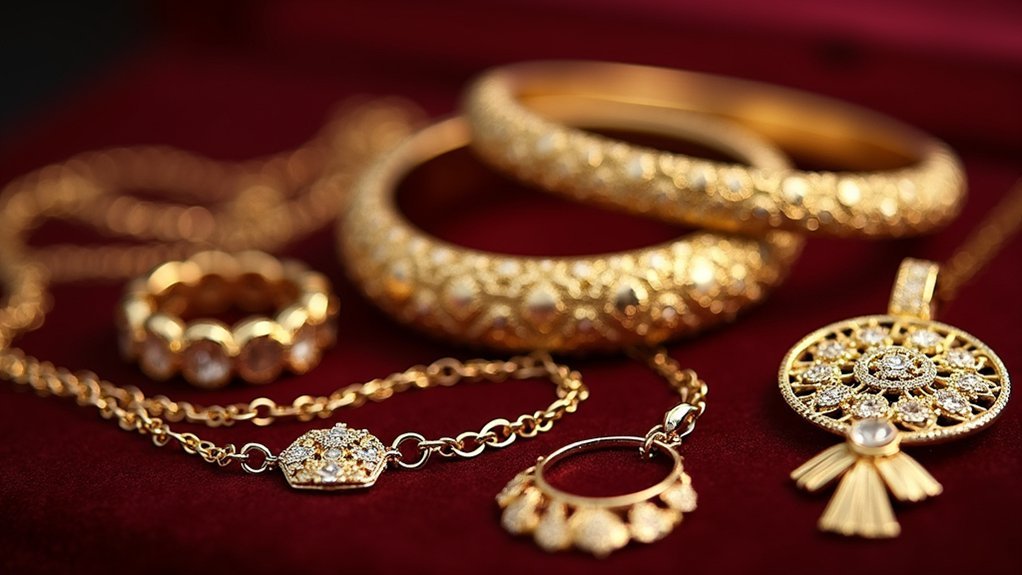
Since solid gold pieces offer unmatched longevity and value retention, they’re the smartest choice for heirloom-quality jewelry that’ll serve as both beautiful accessories and sound investments.
When selecting solid gold for investment purposes, prioritize 14K or 18K engagement rings and wedding bands. These durable pieces maintain their gold look indefinitely without tarnishing, making them perfect for special occasions and daily wear.
You’ll find that solid gold retains its value exceptionally well, often appreciating over time. Because it’s infinitely recyclable, solid gold represents a sustainable investment that minimizes environmental impact.
Consider classic designs like solitaire rings, tennis bracelets, or simple gold chains—these timeless pieces offer the highest cost-per-wear benefit and easily shift between generations as cherished heirloom jewelry.
Maintenance Requirements and Care Instructions
When it comes to maintenance requirements, solid gold jewelry stands out as the most low-maintenance option you can choose. Unlike gold-filled and gold-plated alternatives, solid gold doesn’t tarnish or fade, requiring only occasional cleaning with mild soap and a soft brush to maintain its shine.
Here’s what you need to know about care requirements:
- Gold-plated jewelry demands the most attention – remove before showering or exercising to prevent deterioration.
- Gold-filled pieces need protection from water, sweat, and chemicals to preserve their gold layer and durability.
- Both gold-filled and gold-plated items should be stored in airtight containers to prevent tarnish.
Regular inspections are essential for gold-filled and gold-plated jewelry, as repairs often compromise their longevity by removing protective layers.
Choosing the Right Gold Type for Your Lifestyle
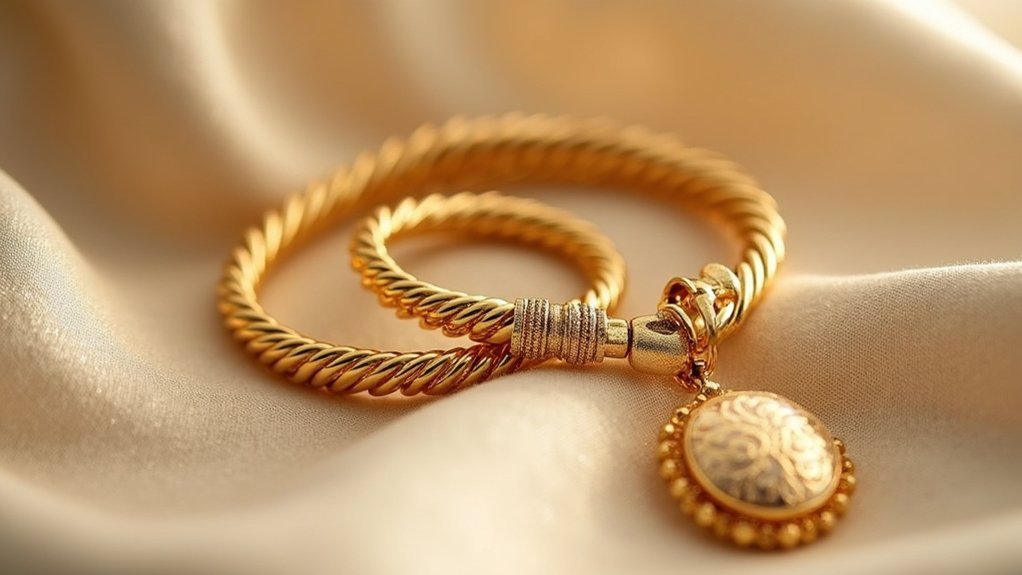
When selecting gold jewelry, you’ll need to match your choice to how often you’ll wear the pieces and what you’re willing to spend.
If you’re looking for everyday jewelry that’ll withstand constant use, solid gold offers unmatched durability but comes with a higher price tag.
Consider your daily activities and budget constraints, as these factors will determine whether gold filled, solid gold, or other options best suit your lifestyle needs.
Daily Wear Considerations
If you’re someone who never takes off their jewelry, solid gold pieces will serve you best for daily wear. These durable options won’t tarnish or fade, making them perfect for constant use.
However, gold filled jewelry offers an excellent middle ground for everyday wear. It’s more affordable than solid gold while lasting up to 30 years with proper care. If you have metal sensitivities, gold filled is superior to gold plated options since its thicker gold layer minimizes contact with base metals.
Consider these daily wear guidelines:
- Solid gold – Best for heirloom pieces you’ll never remove
- Gold filled – Perfect for trendy styles removed nightly
- Gold plated – Avoid for daily wear; reserve for occasional use only
Budget and Durability
Two primary factors should guide your jewelry investment decisions: your available budget and how long you want your pieces to last. Understanding the value proposition of each gold type helps you make smarter choices for your lifestyle.
| Gold Type | Initial Cost | Longevity |
|---|---|---|
| Solid Gold | Highest | Lifetime |
| Gold Filled | Moderate | 30+ years |
| Gold Plated | Lowest | 1-3 years |
While solid gold requires the largest upfront investment, its exceptional durability and minimal maintenance make it more cost-effective long-term. Gold filled jewelry offers excellent value, balancing quality with affordability while resisting tarnishing better than gold plated alternatives. Consider solid gold for heirloom pieces and gold filled for trendy styles that won’t strain your budget.
Frequently Asked Questions
Is Gold Filled Better Than Solid Gold for Permanent Jewelry?
Gold filled isn’t better than solid gold for permanent jewelry. You’ll want solid gold since it doesn’t tarnish, wear down, or need replacement over time, making it ideal for pieces you’ll never remove.
Which Is Better, Vermeil or Gold Filled?
You’ll find gold filled jewelry superior to vermeil because it’s more durable, lasts longer with daily wear, and won’t cause allergic reactions like vermeil’s silver base might.
Does 14K Gold Filled Turn Green?
Yes, 14K gold filled can turn your skin green if moisture reaches the base metal underneath. You’ll minimize this risk by keeping it dry, avoiding sweat exposure, and maintaining the jewelry properly.
Is It Worth It to Buy Solid Gold Jewelry?
You’ll find solid gold jewelry worth buying if you’re seeking a lifetime investment. It won’t tarnish, retains value, causes fewer allergic reactions, and offers excellent cost-per-wear for frequently worn pieces.
In Summary
You’ll find both gold filled and solid gold jewelry serve different purposes in your collection. If you’re building a daily wear wardrobe, gold filled pieces offer excellent durability at accessible prices. When you’re investing in heirloom pieces, solid gold’s the clear winner. Consider your budget, lifestyle, and long-term goals when choosing. Remember, proper care extends both types’ lifespan, so don’t skip maintenance regardless of your selection.

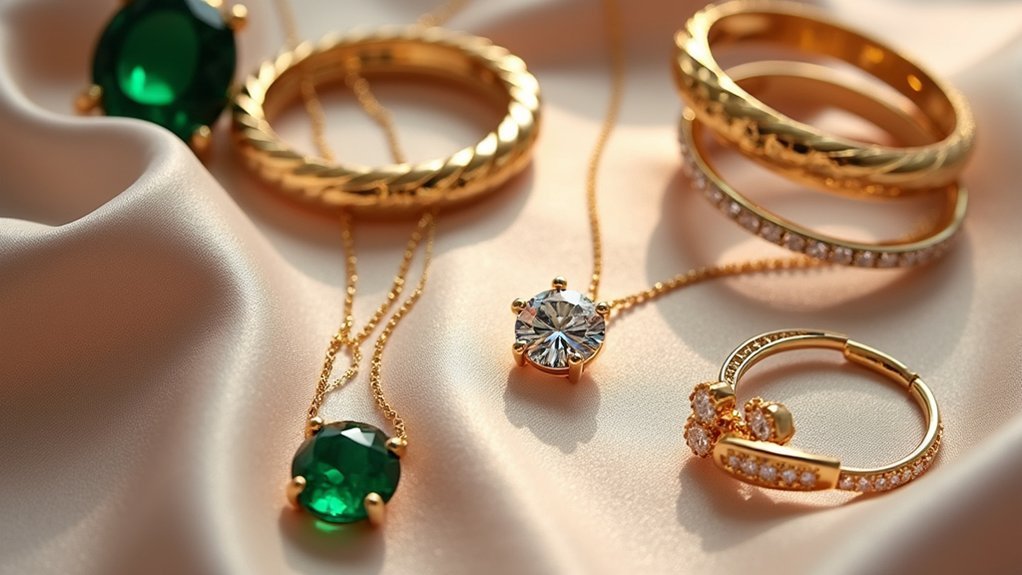



Leave a Reply